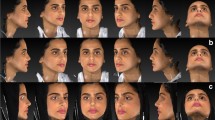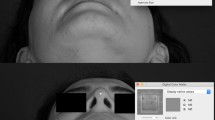Abstract
The field of medical applications is currently one of the most dynamic in medicine due to the great potential for improving clinical practice they hold. However, clinicians’ opinion around their usability in daily clinical care has not been thoroughly addressed. This study aimed to analyze the otolaryngologists response to a rhinoplasty application. It was designed as a survey of 21 otolaryngologists with regards to a rhinoplasty planning application for the iPhone with the capacity to project potential surgery outcomes through tactile morphing software compared to a photo tracing method used as the gold standard. The participants were asked to rate the usefulness of the two technologies on a visual analog scale from 0–10. Questions addressed included four topics: physician–patient communication; imaging process time; perceived usefulness for preoperative planning; and perceived usefulness for surgery. A one sample t-test was applied to compare the scores of both methods for each question. The test subjects (mean age 43.21 years) rated the utility of the iPhone application as superior to that of the photo tracing method (p < 0.05) concluding that the iPhone application could facilitate an immediate preliminary analysis of the options for nasal improvement.





Similar content being viewed by others
References
Pope L, Silva P, Almeyda R (2010) i-Phone applications for the modern day otolaryngologist. Clin Otolaryngol 35:350–354
Dala-Ali BM, Lloyd MA, Al-Abed Y (2011) The uses of the iPhone for surgeons. Surgeon 9:44–48
Amin K (2011) Smartphone applications for the plastic surgery trainee. J Plast Reconstr Aesthet Surg 64:1255–1257
Franko OI, Tirrell TF (2012) Smartphone app use among medical providers in ACGME training programs. J Med Syst 36:3135–3139
Buijink AW, Visser BJ, Marshall L (2012) Medical apps for smartphones: lack of evidence undermines quality and safety. Evid Based Med [Epub ahead of print]
Palma P, Khodaei I, Tasman AJ (2011) A guide to the assessment and analysis of the rhinoplasty patient. Facial Plast Surg 27:146–159
Pedroza F (2002) A 20-year review of the “new domes” technique for refining the drooping nasal tip. Arch Facial Plast Surg 4:157–163
Sevin A, Sevin K, Erdogan B, Adanali G, Deren O (2006) A useful method for planning hump resection of deviated nose. Aesthetic Plast Surg 30:433–436
Mühlbauer W, Holm C (2005) Computer imaging and surgical reality in aesthetic rhinoplasty. Plast Reconstr Surg 115:2098–2104
Ewart CJ, Leonard CJ, Harper JG, Yu J (2006) A simple and inexpensive method of preoperative computer imaging for rhinoplasty. Ann Plast Surg 56:46–49
Adelson RT, DeFatta RJ, Bassischis BA (2008) Objective assessment of the accuracy of computer-simulated imaging in rhinoplasty. Am J Otolaryngol 29:151–155
Moscatiello F (2010) Herrero Jover J, González Ballester MA, Carreño Hernández E, Piombino P, Califano L. Preoperative digital three-dimensional planning for rhinoplasty. Aesthetic Plast Surg 34:232–238
Toriumi DM, Dixon TK (2011) Assessment of rhinoplasty techniques by overlay of before-and-after 3D images. Facial Plast Surg Clin North Am 19:711–723
Hamilton GS 3rd (2010) Morphing images to demonstrate potential surgical outcomes. Facial Plast Surg Clin North Am 18:267–282
Henderson JL, Larrabee WF Jr, Krieger BD (2005) Photographic standards for facial plastic surgery. Arch Facial Plast Surg 7:331–333
Wall S, Kazahaya K, Becker SS, Becker DG (1999) Thirty-five millimetre versus digital photography: comparison of photographic quality and clinical evaluation. Facial Plast Surg 15:101–109
Galdino GM, DaSilva AD, Gunter JP (2002) Digital photography for rhinoplasty. Plast Reconstr Surg 109:1421–1434
Archibald DJ, Carlson ML, Friedman O (2010) Pitfalls of nonstandardized photography. Facial Plast Surg Clin North Am 18:253–266
Riml S, Piontke A, Larcher L, Kompatscher P (2011) Quantification of faults resulting from disregard of standardised facial photography. J Plast Reconstr Aesthet Surg 64:898–901
Aitken RC (1969) Measurement of feelings using visual analogue scales. Proc R Soc Med 62:989–993
Gerich J (2007) Visual analogue scales for mode-independent measurement in self-administered questionnaires. Behav Res Methods 39:985–992
Thomas JR, Freeman MS, Remmler DJ, Ehlert TK (1989) Analysis of patient response to preoperative computerized video imaging. Arch Otolaryngol Head Neck Surg 115:793–796
Conflict of interest
The authors declare that they have no conflict of interest.
Author information
Authors and Affiliations
Corresponding author
Additional information
The data in this article were presented at the free paper section of the Nose & Face World Rome 2012, VII International Congress of the International Federation of Plastic Surgery Societies (IFFPSS) held in Rome, Italy the 12th of May 2012.
Rights and permissions
About this article
Cite this article
Larrosa, F., Dura, M.J., Roura, J. et al. Rhinoplasty planning with an iPhone app: analysis of otolaryngologists response. Eur Arch Otorhinolaryngol 270, 2473–2477 (2013). https://doi.org/10.1007/s00405-013-2360-0
Received:
Accepted:
Published:
Issue Date:
DOI: https://doi.org/10.1007/s00405-013-2360-0




